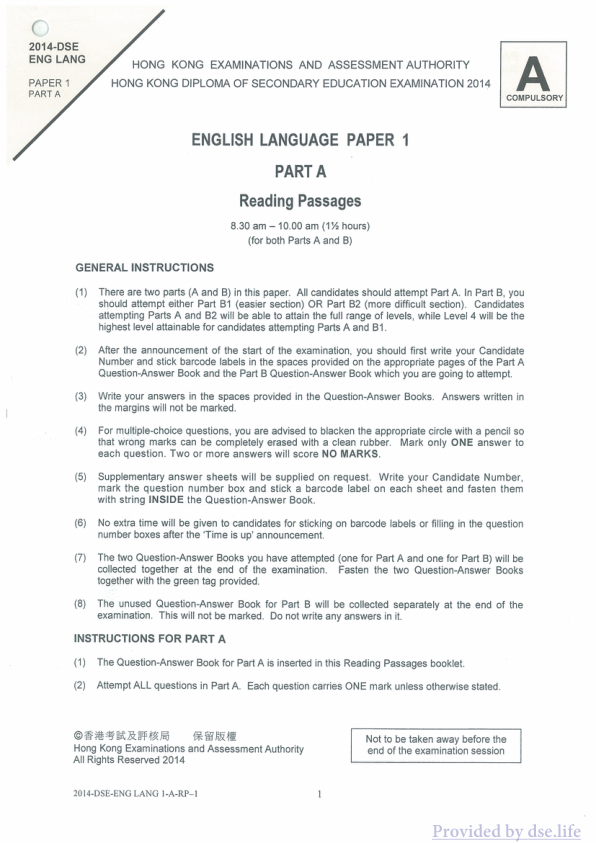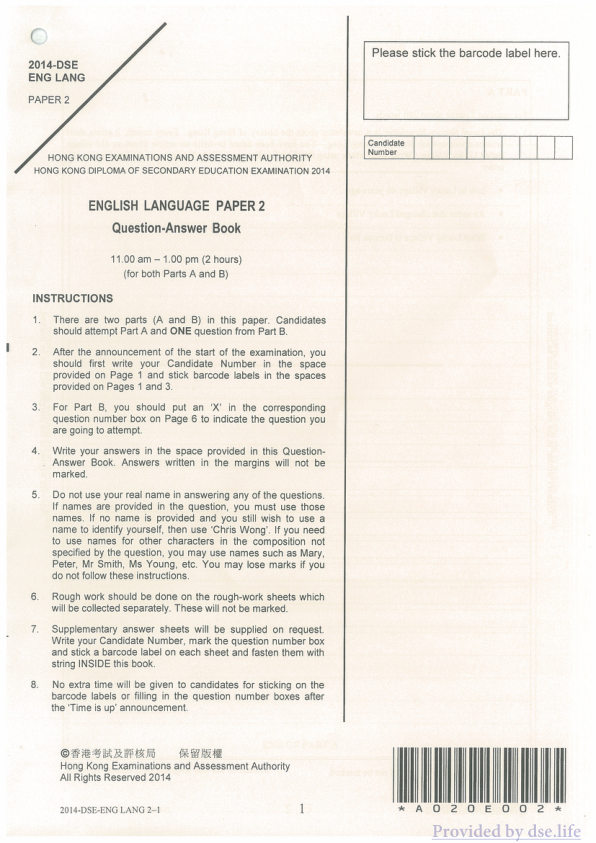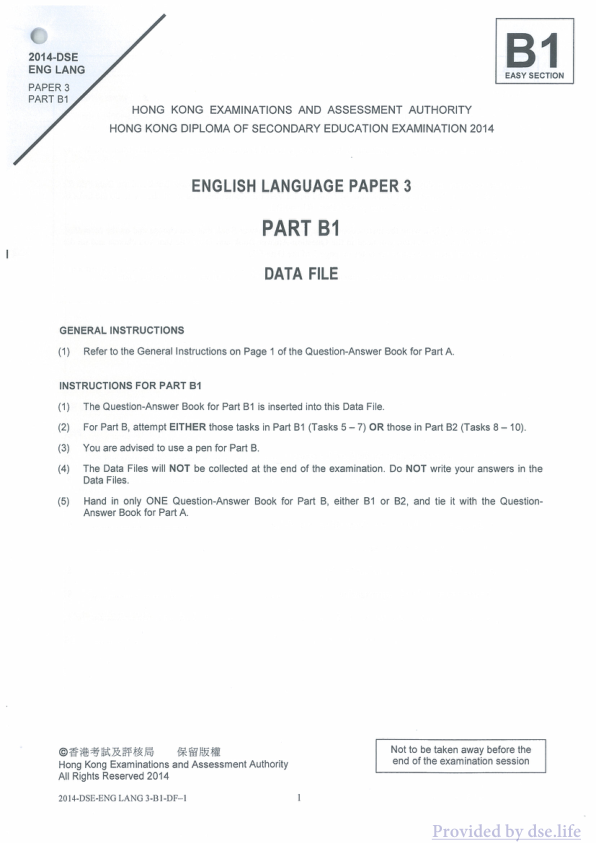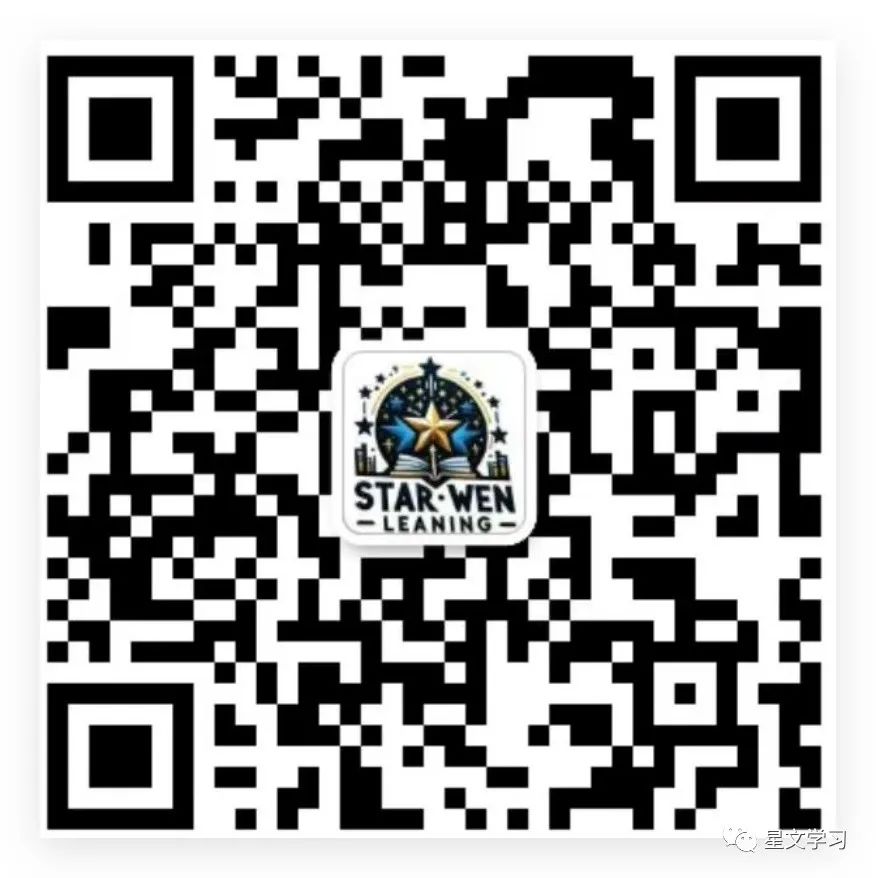2014 DSE 英国语文-English 真题 答案 详解
2014-05-04 dse dse 英国语文-English
| 序号 | 文件列表 | 说明 | ||
|---|---|---|---|---|
| 1 | 2014-英国语文-English-answer.pdf | 36 页 | 6.15MB | 答案 |
| 2 | 2014-英国语文-English-paper1.pdf | 21 页 | 9.28MB | 真题 Paper 1 |
| 3 | 2014-英国语文-English-paper2.pdf | 8 页 | 3.36MB | 真题 Paper 2 |
| 4 | 2014-英国语文-English-paper3.pdf | 39 页 | 14.78MB | 真题 Paper 3 |
| 5 | 2014-英国语文-English-paper4.pdf | 30 页 | 19.70MB | 真题 Paper 4 |
答案
MARKING SCHEMES
This document was prepared for makers' reference. It should not be regarded as a set of model answers. Candidates and teachers who were not involved in the marking process are advised to interpret its content with care.
Paper 1 (Reading)
Part A (compulsory section) 1. C [90] 2. Sales robots/They/It was/were nearly impossible to get rid of // Winston can’t get rid of those sales robots // Winston was afraid the sales robot would try and sell something [64] 3. (The sales robot was trying to) sell something/products // (The sales robot was going to) persuade/make Winston to buy something [63] 4. They worked together (at CommaTech) // They were co-workers/colleagues [74] 5. Future Industries [69] 6. Statement i) At first glance, the robot does not appear to be very impressive. T F NG [48] ii) Rachel knows who Karl is. T F NG [85] iii) Karl and Winston both wanted to work at Future Industries. T F NG [64]
- the (identi)card // Winston’s/his (ID) card [82]
- A [69] 9. Statement i) Winston does not recognize the man in the video. T F NG [82] ii) The job at Future Industries was to build robots. T F NG [82] iii) Karl admits feeling guilty for what he did. T F NG [86]
- C [76]
- B [79]
- i) Elizabeth // wife // mother [76] ii) She was shocked/upset (by Winston’s response/his use of language) // She wanted to calm him down/stop him being angry // He was jumping up and down shouting // He might scare Rachel // It was not appropriate behavior in front of his daughter [55]
- He was miserable/unhappy at CommaTech // He didn’t like his job at CommaTech [53] 14. Winston meets Elizabeth 4 Winston applies for a job at Future Industries 2 Winston works at CommaTech 1 Winston works at IndustriCorp 3 [71]
- (the) job at Future Industries [55]
- Rachel // daughter [43]
- his family // Rachel and Elizabeth // his wife and daughter [74]
- D [69]

真题 Paper 1
2014-DSE ENG LANG PAPER 1 PART A
HONG KONG EXAMINATIONS AND ASSESSMENT AUTHORITY HONG KONG DIPLOMA OF SECONDARY EDUCATION EXAMINATION 2014
A ENGLISH LANGUAGE PAPER 1 PART A Reading Passages 8:30 am - 10:00 am (1½ hours) (for both Parts A and B)
GENERAL INSTRUCTIONS
(1) There are two parts (A and B) in this paper. All candidates should attempt Part A. In Part B, you should attempt either Part B1 (easier section) OR Part B2 (more difficult section). Candidates attempting Parts A and B2 will be able to attain the full range of levels, while Level 4 will be the highest level attainable for candidates attempting Parts A and B1.
(2) After the announcement of the start of the examination, you should first write your Candidate Number and stick barcode labels in the spaces provided on the appropriate pages of the Part A Question-Answer Book and the Part B Question-Answer Book which you are going to attempt.
(3) Write your answers in the spaces provided in the Question-Answer Books. Answers written in the margins will not be marked.
(4) For multiple-choice questions, you are advised to blacken the appropriate circle with a pencil so that wrong marks can be completely erased with a clean rubber. Mark only ONE answer to each question. Two or more answers will score NO MARKS.
(5) Supplementary answer sheets will be supplied on request. Write your Candidate Number, mark the question number box and stick a barcode label on each sheet and fasten them with string INSIDE the Question-Answer Book.
(6) No extra time will be given to candidates for sticking on barcode labels or filling in the question number boxes after the 'Time is up' announcement.
(7) The two Question-Answer Books you have attempted (one for Part A and one for Part B) will be collected together at the end of the examination. Fasten the two Question-Answer Books together with the green tag provided.
(8) The unused Question-Answer Book for Part B will be collected separately at the end of the examination. This will not be marked. Do not write any answers in it.
INSTRUCTIONS FOR PART A
(1) The Question-Answer Book for Part A is inserted in this Reading Passages booklet.
(2) Attempt ALL questions in Part A. Each question carries ONE mark unless otherwise stated.
© Hong Kong Examinations and Assessment Authority All Rights Reserved 2014
Hong Kong Examinations and Assessment Authority
Not to be taken away before the end of the examination session
2014-DSE-ENG LANG 1-A-RP-1

真题 Paper 2
2014-DSE ENG LANG PAPER 2
HONG KONG EXAMINATIONS AND ASSESSMENT AUTHORITY HONG KONG DIPLOMA OF SECONDARY EDUCATION EXAMINATION 2014
ENGLISH LANGUAGE PAPER 2 Question-Answer Book
11:00 am - 1:00 pm (2 hours) (for both Parts A and B)
INSTRUCTIONS
-
There are two parts (A and B) in this paper. Candidates should attempt Part A and ONE question from Part B.
-
After the announcement of the start of the examination, you should first write your Candidate Number in the space provided on Page 1 and stick barcode labels in the spaces provided on Pages 1 and 3.
-
For Part B, you should put an 'X' in the corresponding question number box on Page 6 to indicate the question you are going to attempt.
-
Write your answers in the space provided in this Question-Answer Book. Answers written in the margins will not be marked.
-
Do not use your real name in answering any of the questions. If names are provided in the question, you must use those names. If no name is provided and you still wish to use a name to identify yourself, then use ‘Chris Wong’. If you need to use names for other characters in the composition not specified by the question, you may use names such as Mary, Peter, Mr Smith, Ms Young, etc. You may lose marks if you do not follow these instructions.
-
Rough work should be done on the rough-work sheets which will be collected separately. These will not be marked.
-
Supplementary answer sheets will be supplied on request. Write your Candidate Number, mark the question number box and stick a barcode label on each sheet and fasten them with string INSIDE this book.
-
No extra time will be given to candidates for sticking on the barcode labels or filling in the question number boxes after the ‘Time is up’ announcement.
© Hong Kong Examinations and Assessment Authority All Rights Reserved 2014
Hong Kong Examinations and Assessment Authority
All Rights Reserved 2014
2014-DSE-ENG LANG 2-1
Candidate Number
Please stick the barcode label here.
AO20E002
Provided by dse.life

真题 Paper 3
2014-DSE ENG LANG PAPER 3 PART B1
B1 EASY SECTION
HONG KONG EXAMINATIONS AND ASSESSMENT AUTHORITY HONG KONG DIPLOMA OF SECONDARY EDUCATION EXAMINATION 2014
ENGLISH LANGUAGE PAPER 3 PART B1 DATA FILE
GENERAL INSTRUCTIONS
(1) Refer to the General Instructions on Page 1 of the Question-Answer Book for Part A.
INSTRUCTIONS FOR PART B1
(1) The Question-Answer Book for Part B1 is inserted into this Data File.
(2) For Part B, attempt EITHER those tasks in Part B1 (Tasks 5 - 7) OR those in Part B2 (Tasks 8 - 10).
(3) You are advised to use a pen for Part B.
(4) The Data Files will NOT be collected at the end of the examination. Do NOT write your answers in the Data Files.
(5) Hand in only ONE Question-Answer Book for Part B, either B1 or B2, and tie it with the Question-Answer Book for Part A.
香港考試及評核局保留版權 Hong Kong Examinations and Assessment Authority All Rights Reserved 2014
2014-DSE-ENG LANG 3-B1-DF-1
Not to be taken away before the end of the examination session
Provided by dse.life

真题 Paper 4
2014-DSE ENG LANG PAPER 4 EXAMINER HONG KONG EXAMINATIONS AND ASSESSMENT AUTHORITY HONG KONG DIPLOMA OF SECONDARY EDUCATION EXAMINATION 2014 ENGLISH LANGUAGE PAPER 4 PART A Group Interaction Below is an extract from a website about email: Why Are Young People Abandoning Email? Having an email account used to be cool. You could send people in Africa your thoughts on a new K-Pop song, receive email confirmation for movie tickets you bought on the phone and ignore scam messages. Not anymore. Why? New York Times technology writer Matt Richtel has a theory - email just isn't cool anymore. An email account in the year 2014 is a "sign you're old". It's the technology your Dad uses". And, as we all know, the last thing a teenager wants to be is like his Dad. It also requires a "boringly long process of signing into an account, typing out a subject line and then sending a message that might not be received or answered for hours". Teens, needless to say, do not have time for this sort of nonsense. As Ken Kamau, a 17-year-old student from Nairobi writes, “I don’t use email for casual correspondence, why would I? It’s too formal and unnecessary, it would be like writing your friend a long letter asking if they wanted to get coffee next Tuesday.” Which is probably why, as Richtel notes, the “number of visitors in the United States to major e-mail sites like Yahoo! and Hotmail is now in steady decline, peaking as long ago as November 2009”. Yahoo! Senior Director of Product Management David McDowell, however, points out many email functions (attachments, cc lines) are not designed for teenagers anyway. Maybe they’ll come around when they enter the workplace. You are preparing to give a talk in your school to school leavers about writing emails in their lives after leaving school. You may want to talk about: whether young people write emails in their daily lives the challenges young people may face when writing formal emails the advantages of using email over other forms of communication anything else you think is important PART B Individual Response 1. Do you write emails often? 2. Do you find writing emails easy or difficult? 3. What is the most popular way for young people to communicate with each other? 4. Do you prefer writing an email or writing a letter? 5. What is the hardest thing about writing a formal email? 6. What kinds of letters cannot be replaced by emails? 7. Why do you think emails have replaced letters? 8. Do you agree that using emails is a sign that you are old? 74 DO NOT TAKE AWAY Provided by dselife

